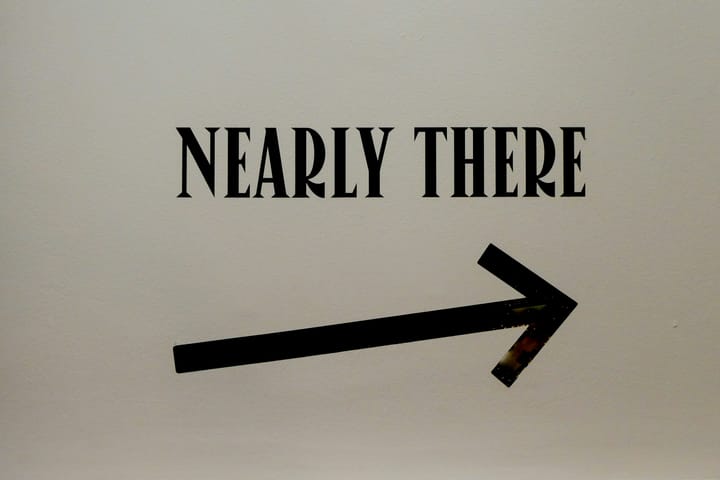What Motivates You? Learn the Types of Motivation and How to Use Them
Learn the types of motivation, why it’s important to understand what motivates you, and how to increase your motivation.

22 minutes into what I had been told was a 4.5-hour hike, I thought about quitting.
I looked up at the trail ahead and it was steep… really, really, steep. I looked back the way I had come, already feeling the burn in my legs and lungs.
I had told several people I was doing this particular hike. When they inevitably asked me about it after, what would I tell them if I quit?
- Would I lie and say I finished it?
- Would I lie another way, and say I spotted some bear scat and turned around?
- Would I fess up and tell them it looked too hard?
I wondered how I would feel about myself if I quit (or lied), and dismissed each option.
I’m not a liar or a quitter.
I sighed, once more looked longly back on the path I had already come up, and continued forward.

At 44 minutes into the hike, I was regretting my life choices.
I wondered if I could indeed become a liar or quitter…or just curl up on the path for a bit until another hiker found me 😅. I considered whether a bear sighting would be as bad as I imagined since it would give me a legitimate excuse to turn around.
And still, I continued to huff and puff my way forward. (Though truth be told, the words… “You have got to be 🤬 kidding me,” left my mouth at several junctures as I rounded a switchback and came upon yet another steep slope to climb.)
A short time later I came upon a bench that I recalled was halfway up the ascent. This meant I was 1/4 of the way through the hike. This didn’t make sense since it was supposed to be 4.5-hours but I assumed I misremembered how far into the hike the bench was.
I took a break to sit on the bench and take in the view while two other hikers passed me on their way down. I noted that they seemed to be reasonable humans in no better shape than I was and had managed (I assume) to reach the top.
Yet again, as I tried to get my heart rate below 165bpm, I considered my options.
I had come this far, there was no sign of bears, and those other people had done it and hadn’t keeled over. So far it had been hard, but not impossible. I had come this far and knew I could do it. I also knew I would feel good once I finished… I decided, once again, to keep going.
I had a sip of water, re-buckled my sweaty backpack, took a deep breath, and trekked forward with newfound determination and acceptance that I was in it until the end… or so I thought.
Pause! I have another reflection from the hike to share with you but it’s continued in my next article. Otherwise, this will be too long!😁
Types of motivation: intrinsic versus extrinsic
As I thought more about my motivations for this particular expedition, I considered motivation and the significant part it plays in our lives.
Having clarity on what motivates you is foundational to both acting and living with intention. It’s vital to understand your own motivations as you make decisions in your day-to-day life. When you know what motivates you, it’s easier to understand why you do some things and not others.
And when you know why you do things, it’s easier to change, improve, and focus on what matters.
Humans have two basic types of motivation:
Intrinsic motivation
Intrinsic motivation is when you engage in a behaviour because you find it rewarding. You are performing an activity for its own sake rather than from the desire for some external reward. The behaviour itself is its own reward.[1]
Examples:
- Exercising alone because you like how it makes you feel
- Travelling because you enjoy learning about different cultures
- Volunteering because you want to help others
- Studying because you are interested in a particular topic
- Learning a new skill because it’s fun
Extrinsic motivation
Extrinsic motivation is when you are motivated to perform a behaviour or engage in an activity because you want to earn a reward or avoid punishment. You will engage in behaviour not because you enjoy it or because you find it satisfying, but because you expect to get something in return or avoid something unpleasant.[2]
Examples:
- Studying hard because you want to pass an exam
- Enrolling in a specific university program because you want to make your parents proud
- Working at a job because you want to make money
- Doing the dishes because you don’t want to make your partner mad
- Volunteering because it looks good on a resume
In the case of my hike, while I indeed thought about what others would think of me and felt motivated to keep going to avoid their judgement (an extrinsic motivator), I also kept going because I wanted to prove to myself that I could and I knew I would feel good after (intrinsic motivators).

Reflect on your motivations
Neither intrinsic (internal) nor extrinsic (external) motivation is inherently good or bad. They are data points about why you do what you do. As was the case for me, you likely have a mix of motivations for the things you do, some intrinsic and some extrinsic. Your motivations do not have to be, and are likely not, one or the other.
Primarily extrinsic motivation can lead to a reduction in intrinsic motivation. The motivation of getting a reward or to avoid something unpleasant is often less sustainable than the motivation of doing something for its own sake.
For example, only being motivated to do the hike because I didn’t want my friends to think poorly of me would not have felt as good as doing it because I enjoyed the challenge and how I felt after.
When you think about living an intentional life, your motivations play a key role in:
- How you make decisions
- What you prioritize
- How you behave
Your motivations are another way to articulate what’s important to you and what you value.
- What motivates you to do the things you do each day?
- What motivates your decision to do one thing over another?
- What motivates you to keep doing something or to stop?
As with all your choices and behaviours, the first step to being intentional about them is to notice them. It’s understanding why you are motivated to do some things and not others.
Be motivated for the “right” reasons
When you think about your motivations, it’s powerful to know if you do things for the “right” reasons. The right reasons are often things that bring you joy or fulfillment and are what will help you:
- Be consistent
- Feel good about your decisions and actions
- Stay committed to your chosen path
Being motivated for the “wrong” reasons is much harder. In my mind, the wrong reasons are usually related to fear.
Fear-motivated decisions
Fear-motivated decisions are ones you make because you are afraid of a potential outcome versus actually wanting to do something. You can read more about fear-motivated decision-making in my article 7 Strategies to Stop Fear-Based Decision-Making.
The gist is that there are several fear-based motivators--and they are joyless! They take away from your experience and cost you time and energy. The fear-based motivators I captured are:
- Fear of missing out on money
- Fear of missing out on a connection
- Fear of not being liked (aka people-pleasing)
- Fear of conflict
- Fear of judgement
When you are motivated by fear, it’s more challenging to keep going. There is less satisfaction in your accomplishments and you often end up doing things you don’t want to do at your own expense.
As you reflect on your motivations, think about where they come from.
- Are you doing something because you are afraid of what will happen if you don’t?
- Are you doing it because it brings you satisfaction, fulfillment, joy and purpose?
The answer will help you determine if you need to make a change.
Get motivated: 5 Ways to Increase Your Motivation
Another advantage to having clarity on your motivations is it gives you the opportunity to create conditions that motivate you.
When you know what motivates you, you can take steps to make it happen and move those mountains!
1. Get clarity on your values
When you know what you value, you can identify how an activity or goal will support and foster those values.
What types of things are intrinsic motivators for you?
- What makes you feel good?
- What do you believe in?
- What kind of person do you want to be?
- What makes you happy?
- What are you curious about?
- What types of interactions do you enjoy?
- What makes you feel secure?
- What fascinates you?
In the example of my hike, I was motivated by wanting to be a person who has a decent level of fitness and the feeling I get after a good workout.
2. Identify what YOU want to do
Autonomy is an important part of motivation. When you decide to try something, consider whether it’s what you think you should want to do or what someone else has said you should do. Those conditions are often not enough to sustain a behaviour or activity. It’s hard to keep moving forward on something that you don’t really care about or are not invested in.
When you choose to do something that YOU believe in, are interested in, or enjoy, you are much more likely to keep at it.
For example, if you decide you want to take a writing class but don’t enjoy poetry, don’t start with the poetry course your friend LOVED. Pick something that excites you.

3. Find a place where you feel like you belong
Find a community or group to join to encourage you to keep going. When you feel like you belong, it’s easier to want to do something. You get supported and, in turn, support others. Join a walking group with a friend or a theatre club or a dancing troupe.
For example, my husband plays squash several times a week with his twin brother. On a cold snowy evening, it’s a lot easier for him to go to the squash club when he knows he will get to see his brother.
4. Match your activity to (or slightly above) your ability
When something is too easy or too hard it’s unengaging and more difficult to stick with. Instead, when you decide to do something, think about your current knowledge or ability.
- What seems like a reasonable starting point where you will feel competent, but also challenged?
- Are you able to adjust the level of difficulty up or down?
For example, if you decide you want to take up running then don’t start with a marathon. On the flip side, if you’re a college-level basketball player then don’t sign up for a recreational basketball league.
5. Integrate Extrinsic Rewards with Intrinsic Rewards
There is nothing wrong with being motivated by extrinsic rewards. Extrinsic rewards will enhance and encourage progress on activities that are already intrinsically motivated.
For example, during my hike, I decided that some pizza would be a wonderful way to reward myself after such a strenuous activity. (And it was!). It definitely contributed to my desire to keep going up those rocky inclines!
Understanding what motivates you is foundational to intention. When you reflect and articulate what motivates you, you can then integrate those motivations into your day-to-day life and activities. You will more easily recognize decisions (or potential decisions) that are fear-motivated and make more sustainable, healthier choices. And you are able to create conditions that will help you reach your goals and keep working on and doing the things that are important to you.
What is motivating you to move your (metaphorical 😅) mountains?
Do you need help getting motivated to finish (or start!) a project? Motivation is one of the first things to suffer when you are heading down the road to burnout. Let's chat about how I can help you get back on track.
Share
Ashley Janssen

Productivity consultant, writer, speaker, serial entrepreneur, chaos calmer, introvert, cat-lady. Lover of books, fitness, old fashioned’s, basketball, and video games.
Follow me on
Twitter
or
LinkedIn.
Hire me for
1 on 1 productivity consulting
or
speaking.
Related articles

How to Stay Productive When Things Calm Down

How To Keep Up With Your Daily Habits


Comments ()